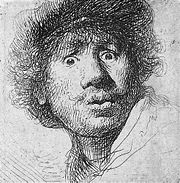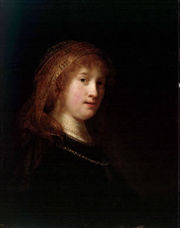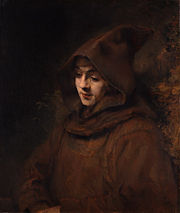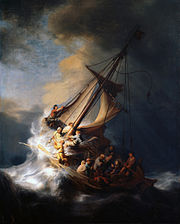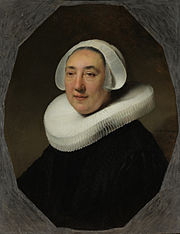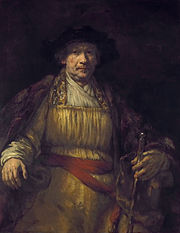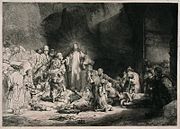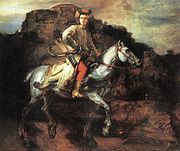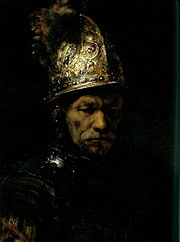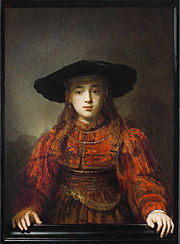
Rembrandt
Background to the schools Wikipedia
This Schools selection was originally chosen by SOS Children for schools in the developing world without internet access. It is available as a intranet download. Sponsoring children helps children in the developing world to learn too.
| Rembrandt van Rijn | |
|---|---|
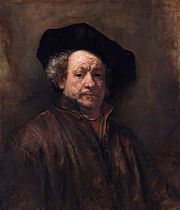 Self-portrait by Rembrandt (1660). |
|
| Birth name | Rembrant Harmenszoon van Rijn |
| Nationality | Dutch |
| Field | Painting, Printmaking |
| Movement | Dutch Golden Age Baroque |
| Works |
Danaë, 1636 |
Rembrandt Harmenszoon van Rijn (Dutch pronunciation: [ˈrɛmbrɑnt ˈɦɑrmənsoːn vɑn ˈrɛin], July 15, 1606 – October 4, 1669) was a Dutch painter and etcher. He is generally considered one of the greatest painters and printmakers in European art history and the most important in Dutch history. His contributions to art came in a period that historians call the Dutch Golden Age.
Having achieved youthful success as a portrait painter, his later years were marked by personal tragedy and financial hardships. Yet his etchings and paintings were popular throughout his lifetime, his reputation as an artist remained high, and for twenty years he taught many important Dutch painters. Rembrandt's greatest creative triumphs are exemplified especially in his portraits of his contemporaries, self-portraits and illustrations of scenes from the Bible. His self-portraits form a unique and intimate biography, in which the artist surveyed himself without vanity and with the utmost sincerity.
In his paintings and prints he exhibited knowledge of classical iconography, which he molded to fit the requirements of his own experience; thus, the depiction of a biblical scene was informed by Rembrandt's knowledge of the specific text, his assimilation of classical composition, and his observations of Amsterdam's Jewish population. Because of his empathy for the human condition, he has been called "one of the great prophets of civilization."
Life
Rembrandt Harmenszoon van Rijn was born on July 15, 1606 in Leiden, in the Dutch Republic, nowadays the Netherlands. He was the ninth child born to Harmen Gerritszoon van Rijn and Neeltgen Willemsdochter van Zuytbrouck. His family was quite well-to-do; his father was a miller and his mother was a baker's daughter. As a boy he attended Latin school and was enrolled at the University of Leiden, although according to a contemporary he had a greater inclination towards painting; he was soon apprenticed to a Leiden history painter, Jacob van Swanenburgh, with whom he spent three years. After a brief but important apprenticeship of six months with the famous painter Pieter Lastman in Amsterdam, Rembrandt opened a studio in Leiden in 1624 or 1625, which he shared with friend and colleague Jan Lievens. In 1627, Rembrandt began to accept students, among them Gerrit Dou.
In 1629, Rembrandt was discovered by the statesman Constantijn Huygens, the father of Christiaan Huygens (a famous Dutch mathematician and physicist), who procured for Rembrandt important commissions from the court of The Hague. As a result of this connection, Prince Frederik Hendrik continued to purchase paintings from Rembrandt until 1646.
At the end of 1631, Rembrandt moved to Amsterdam, then rapidly expanding as the new business capital of the Netherlands, and began to practice as a professional portraitist for the first time, with great success. He initially stayed with an art dealer, Hendrick van Uylenburg, and in 1634, married Hendrick's cousin, Saskia van Uylenburg. Saskia came from a good family: her father had been lawyer and burgemeester (mayor) of Leeuwarden. When Saskia, as the youngest daughter, became an orphan, she lived with an older sister in Het Bildt. They were married in the local church of St. Annaparochie without the presence of his relatives. In the same year, Rembrandt became a burgess of Amsterdam and a member of the local guild of painters. He also acquired a number of students, among them Ferdinand Bol and Govert Flinck.
In 1635, Rembrandt and Saskia moved into their own house, renting in fashionable Nieuwe Doelenstraat. In 1639, they moved to a prominent house (now the Rembrandt House Museum) in the Jodenbreestraat in what was becoming the Jewish quarter; the mortgage to finance the 13,000 guilder purchase would be a primary cause for later financial difficulties. He should easily have been able to pay it off with his large income, but it appears his spending always kept pace with his income, and he may have made some unsuccessful investments. It was there that Rembrandt frequently sought his Jewish neighbors to model for his Old Testament scenes. Although they were by now affluent, the couple suffered several personal setbacks; their son Rumbartus died two months after his birth in 1635 and their daughter Cornelia died at just 3 weeks of age in 1638. In 1640, they had a second daughter, also named Cornelia, who died after living barely over a month. Only their fourth child, Titus, who was born in 1641, survived into adulthood. Saskia died in 1642 soon after Titus's birth, probably from tuberculosis. Rembrandt's drawings of her on her sick and death bed are among his most moving works.
During Saskia's illness, Geertje Dircx was hired as Titus' caretaker and nurse and probably also became Rembrandt's lover. She would later charge Rembrandt with breach of promise and was awarded alimony of 200 guilders a year. Rembrandt worked to have her committed for twelve years to an asylum or poorhouse (called a "bridewell") at Gouda, after learning Geertje had pawned jewelry that had once belonged to Saskia, and which Rembrandt had given her.
In the late 1640s, Rembrandt began a relationship with the much younger Hendrickje Stoffels, who had initially been his maid. In 1654 they had a daughter, Cornelia, bringing Hendrickje a summons from the Reformed Church to answer the charge "that she had committed the acts of a whore with Rembrandt the painter". She admitted this and was banned from receiving communion. Rembrandt was not summoned to appear for the Church council because he was not a member of the Reformed Church. The two were considered legally wed under common law, but Rembrandt had not married Henrickje, so as not to lose access to a trust set up for Titus in his mother's will.
Rembrandt lived beyond his means, buying art (including bidding up his own work), prints (often used in his paintings) and rarities, which probably caused a court arrangement to avoid his bankruptcy in 1656, by selling most of his paintings and large collection of antiquities. The sale list survives and gives us a good insight into his collections, which apart from Old Master paintings and drawings included busts of the Roman Emperors, suits of Japanese armor among many objects from Asia, and collections of natural history and minerals; the prices realized in the sales in 1657 and 1658 were disappointing. He was forced to sell his house and his printing-press and move to more modest accommodation on the Rozengracht in 1660. The authorities and his creditors were generally accommodating to him, except for the Amsterdam painters' guild, who introduced a new rule that no one in Rembrandt's circumstances could trade as a painter. To get round this, Hendrickje and Titus set up a business as art-dealers in 1660, with Rembrandt as an employee.
In 1661, he (or rather the new business) was contracted to complete work for the newly built city hall, but only after Govert Flinck, the artist previously commissioned, died without beginning to paint. The resulting work, The Conspiracy of Claudius Civilis, was rejected and returned to the painter; the surviving fragment is only a fraction of the whole work. It was around this time that Rembrandt took on his last apprentice, Aert de Gelder. In 1662 he was still fulfilling major commissions for portraits and other works. When Cosimo III de' Medici, Grand Duke of Tuscany visited Amsterdam in 1667, he visited Rembrandt at his house.
Rembrandt outlived both Hendrickje, who died in 1663, and Titus, who died in 1668, leaving a baby daughter. Rembrandt died within a year of his son, on October 4, 1669 in Amsterdam, and was buried in an unmarked grave in the Westerkerk.
Works
In a letter to Huyghens, Rembrandt offered the only surviving explanation of what he sought to achieve through his art: the greatest and most natural movement, translated from de meeste en de natuurlijkste beweegelijkheid. The word "beweechgelickhijt" is also argued to mean "emotion" or "motive." Whether this refers to objectives, material or otherwise is open to interpretation; either way, Rembrandt seamlessly melded the earthly and spiritual as has no other painter in Western art.
Earlier 20th century connoisseurs claimed Rembrandt had produced over 600 paintings, nearly 400 etchings and 2,000 drawings. More recent scholarship, from the 1960s to the present day (led by the Rembrandt Research Project), often controversially, has winnowed his oeuvre to nearer 300 paintings. His prints, traditionally all called etchings, although many are produced in whole or part by engraving and sometimes drypoint, have a much more stable total of slightly under 300. It is likely he made many more drawings in his lifetime than 2,000, but those extant are more rare than presumed. Two experts claim that the number of drawings whose autograph status can be regarded as effectively "certain" is no higher than about 75, although this is disputed. The list was to be unveiled at a scholarly meeting in February 2010.
At one time about ninety paintings were counted as Rembrandt self-portraits, but it is now known that he had his students copy his own self-portraits as part of their training. Modern scholarship has reduced the autograph count to over forty paintings, as well as a few drawings and thirty-one etchings, which include many of the most remarkable images of the group. Some show him posing in quasi-historical fancy dress, or pulling faces at himself. His oil paintings trace the progress from an uncertain young man, through the dapper and very successful portrait-painter of the 1630s, to the troubled but massively powerful portraits of his old age. Together they give a remarkably clear picture of the man, his appearance and his psychological make-up, as revealed by his richly weathered face.
In a number of biblical works, including The Raising of the Cross, Joseph Telling His Dreams and The Stoning of Saint Stephen, Rembrandt painted himself as a character in the crowd. Durham suggests that this was because the Bible was for Rembrandt, "a kind of diary, an account of moments in his own life."
Among the more prominent characteristics of his work are his use of chiaroscuro, the theatrical employment of light and shadow derived from Caravaggio, or, more likely, from the Dutch Caravaggisti, but adapted for very personal means. Also notable are his dramatic and lively presentation of subjects, devoid of the rigid formality that his contemporaries often displayed, and a deeply felt compassion for mankind, irrespective of wealth and age. His immediate family—his wife Saskia, his son Titus and his common-law wife Hendrickje—often figured prominently in his paintings, many of which had mythical, biblical or historical themes.
Periods, themes and styles
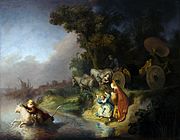
Throughout his career Rembrandt took as his primary subjects the themes of portraiture, landscape and narrative painting. For the last, he was especially praised by his contemporaries, who extolled him as a masterful interpreter of biblical stories for his skill in representing emotions and attention to detail. Stylistically, his paintings progressed from the early 'smooth' manner, characterized by fine technique in the portrayal of illusionistic form, to the late 'rough' treatment of richly variegated paint surfaces, which allowed for an illusionism of form suggested by the tactile quality of the paint itself.
A parallel development may be seen in his skill as a printmaker. In the etchings of his maturity, particularly from the late 1640s onward, the freedom and breadth of his drawings and paintings found expression in the print medium as well. The works encompass a wide range of subject matter and technique, sometimes leaving large areas of white paper to suggest space, at other times employing complex webs of line to produce rich dark tones.
It was during Rembrandt's Leiden period (1625–1631) that Lastman's influence was most prominent. It is also likely that at this time Lievens had a strong impact on his work as well. Paintings were rather small, but rich in details (for example, in costumes and jewelry). Religious and allegorical themes were favored, as were tronies, half-length figures not intended as specific portraits. In 1626 Rembrandt produced his first etchings, the wide dissemination of which would largely account for his international fame. In 1629 he completed Judas Repentant, Returning the Pieces of Silver and The Artist in His Studio, works that evidence his interest in the handling of light and variety of paint application, and constitute the first major progress in his development as a painter.
During his early years in Amsterdam (1632–1636), Rembrandt began to paint dramatic biblical and mythological scenes in high contrast and of large format (The Blinding of Samson, 1636, Belshazzar's Feast, c. 1635 Danaë, 1636), seeking to emulate the baroque style of Rubens. With the occasional help of assistants in Uylenburgh's workshop, he painted numerous portrait commissions both small ( Jacob de Gheyn III) and large (Portrait of the Shipbuilder Jan Rijcksen and his Wife, 1633, Anatomy Lesson of Dr. Nicolaes Tulp, 1632).
By the late 1630s, Rembrandt had produced a few paintings and many etchings of landscapes. Often these landscapes highlighted natural drama, featuring uprooted trees and ominous skies (Cottages before a Stormy Sky, c. 1641, The Three Trees, 1643). From 1640 his work became less exuberant and more sober in tone, possibly reflecting personal tragedy. Biblical scenes were now derived more often from the New Testament than the Old Testament, as had been the case before. In 1642 he painted The Night Watch, the most notable of the important group portrait commissions which he received in this period, and through which he sought to find solutions to compositional and narrative problems that had been attempted in previous works.
In the decade following the Night Watch, Rembrandt's paintings varied greatly in size, subject, and style. The previous tendency to create dramatic effects primarily by strong contrasts of light and shadow gave way to the use of frontal lighting and larger and more saturated areas of colour. Simultaneously, figures came to be placed parallel to the picture plane. These changes can be seen as a move toward a classical mode of composition and, considering the more expressive use of brushwork as well, may indicate a familiarity with Venetian art (Susanna and the Elders, 1637–47). At the same time, there was a marked decrease in painted works in favour of etchings and drawings of landscapes. In these graphic works natural drama eventually made way for quiet Dutch rural scenes.
In the 1650s, Rembrandt's style changed again. Colors became richer and brush strokes more pronounced. With these changes, Rembrandt distanced himself from earlier work and current fashion, which increasingly inclined toward fine, detailed works. His singular approach to paint application may have been suggested in part by familiarity with the work of Titian, and could be seen in the context of the then current discussion of 'finish' and surface quality of paintings. Contemporary accounts sometimes remark disapprovingly of the coarseness of Rembrandt's brushwork, and the artist himself was said to have dissuaded visitors from looking too closely at his paintings. The tactile manipulation of paint may hearken to medieval procedures, when mimetic effects of rendering informed a painting's surface. The end result is a richly varied handling of paint, deeply layered and often apparently haphazard, which suggests form and space in both an illusionistic and highly individual manner.
In later years, biblical themes were still depicted often, but emphasis shifted from dramatic group scenes to intimate portrait-like figures (James the Apostle, 1661). In his last years, Rembrandt painted his most deeply reflective self-portraits (from 1652 to 1669 he painted fifteen), and several moving images of both men and women ( The Jewish Bride, ca. 1666)—in love, in life, and before God .
Etchings
Rembrandt produced etchings for most of his career, from 1626 to 1660, when he was forced to sell his printing-press and virtually abandoned etching. Only the troubled year of 1649 produced no dated work. He took easily to etching and, though he also learned to use a burin and partly engraved many plates, the freedom of etching technique was fundamental to his work. He was very closely involved in the whole process of printmaking, and must have printed at least early examples of his etchings himself. At first he used a style based on drawing, but soon moved to one based on painting, using a mass of lines and numerous bitings with the acid to achieve different strengths of line. Towards the end of the 1630s, he reacted against this manner and moved to a simpler style, with fewer bitings. He worked on the so-called Hundred Guilder Print in stages throughout the 1640s, and it was the "critical work in the middle of his career", from which his final etching style began to emerge. Although the print only survives in two states, the first very rare, evidence of much reworking can be seen underneath the final print and many drawings survive for elements of it.
In the mature works of the 1650s, Rembrandt was more ready to improvise on the plate and large prints typically survive in several states, up to eleven, often radically changed. He now uses hatching to create his dark areas, which often take up much of the plate. He also experimented with the effects of printing on different kinds of paper, including Japanese paper, which he used frequently, and on vellum. He began to use "surface tone," leaving a thin film of ink on parts of the plate instead of wiping it completely clean to print each impression. He made more use of drypoint, exploiting, especially in landscapes, the rich fuzzy burr that this technique gives to the first few impressions.
His prints have similar subjects to his paintings, although the twenty-seven self-portraits are relatively more common, and portraits of other people less so. There are forty-six landscapes, mostly small, which largely set the course for the graphic treatment of landscape until the end of the 19th century. One third of his etchings are of religious subjects, many treated with a homely simplicity, whilst others are his most monumental prints. A few erotic, or just obscene, compositions have no equivalent in his paintings. He owned, until forced to sell it, a magnificent collection of prints by other artists, and many borrowings and influences in his work can be traced to artists as diverse as Mantegna, Raphael, Hercules Segers, and Giovanni Benedetto Castiglione.
Night Watch
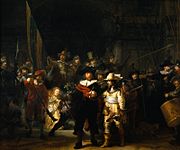
Rembrandt painted The Militia Company of Captain Frans Banning Cocq between 1640 and 1642. This picture was called the Nachtwacht by the Dutch and the Night Watch by Sir Joshua Reynolds because by the 18th century the picture was so dimmed and defaced by time that it was almost indistinguishable and it looked quite like a night scene. After it was cleaned, it was discovered to represent broad day—a party of musketeers stepping from a gloomy courtyard into the blinding sunlight.
The piece was commissioned for the new hall of the Kloveniersdoelen, the musketeer branch of the civic militia. Rembrandt departed from convention, which ordered that such genre pieces should be stately and formal, rather a line-up than an action scene. Instead he showed the militia readying themselves to embark on a mission (what kind of mission, an ordinary patrol or some special event, is a matter of debate).
Contrary to what is often said the work was hailed as a success from the beginning. Parts of the canvas were cut off (approximately 20% from the left hand side was removed) to make the painting fit its new position when it was moved to Amsterdam town hall in 1715; the Rijksmuseum has a smaller copy of what is thought to be the full original composition; the four figures in the front are at the centre of the canvas. The painting is now in the Rijksmuseum, Amsterdam.
Expert assessments
In 1968 the Rembrandt Research Project was started under the sponsorship of the Netherlands Organization for the Advancement of Scientific Research; it was initially expected to last a highly optimistic ten years. Art historians teamed up with experts from other fields to reassess the authenticity of works attributed to Rembrandt, using all methods available, including state-of-the-art technical diagnostics, and to compile a complete new catalogue raisonné of his paintings. As a result of their findings, many paintings that were previously attributed to Rembrandt have been removed from their list, although others have been added back. Many of those removed are now thought to be the work of his students.
One example of activity is The Polish Rider, in New York's Frick Collection. Its authenticity had been questioned years before by several scholars, led by Julius Held. Many, including Dr. Josua Bruyn of the Foundation Rembrandt Research Project, attributed the painting to one of Rembrandt's closest and most talented pupils, Willem Drost, about whom little is known. The Frick itself never changed its own attribution, the label still reading "Rembrandt" and not "attributed to" or "school of". More recent opinion has shifted in favour of the Frick, with Simon Schama in his 1999 book Rembrandt's Eyes, and a Rembrandt Project scholar, Ernst van de Wetering (Melbourne Symposium, 1997) both arguing for attribution to the master. Many scholars feel that the execution is uneven, and favour different attributions for different parts of the work.
Another painting, Pilate Washing His Hands, is also of questionable attribution. Critical opinion of this picture has varied since 1905, when Wilhelm von Bode described it as "a somewhat abnormal work" by Rembrandt. Scholars have since dated the painting to the 1660s and assigned it to an anonymous pupil, possibly Arent de Gelder. The composition bears superficial resemblance to mature works by Rembrandt but lacks the master's command of illumination and modeling.
The attribution and re-attribution work is ongoing. In 2005 four oil paintings previously attributed to Rembrandt's students were reclassified as the work of Rembrandt himself: Study of an Old Man in Profile and Study of an Old Man with a Beard from a US private collection, Study of a Weeping Woman, owned by the Detroit Institute of Arts, and Portrait of an Elderly Woman in a White Bonnet, painted in 1640.
Rembrandt's own studio practice is a major factor in the difficulty of attribution, since, like many masters before him, he encouraged his students to copy his paintings, sometimes finishing or retouching them to be sold as originals, and sometimes selling them as authorized copies. Additionally, his style proved easy enough for his most talented students to emulate. Further complicating matters is the uneven quality of some of Rembrandt's own work, and his frequent stylistic evolutions and experiments. As well, there were later imitations of his work, and restorations which so seriously damaged the original works that they are no longer recognizable. It is highly likely that there will never be universal agreement as to what does and what does not constitute a genuine Rembrandt.
Name and signature
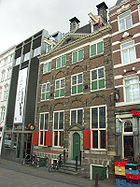
"Rembrandt" is a modification of the spelling of the artist's first name that he introduced in 1633. Roughly speaking, his earliest signatures (ca. 1625) consisted of an initial "R", or the monogram "RH" (for Rembrant Harmenszoon; i.e. "Rembrant, the son of Harmen"), and starting in 1629, "RHL" (the "L" stood, presumably, for Leiden). In 1632, he used this monogram early in the year, then added his patronymic to it, "RHL-van Rijn", but replaced this form in that same year and began using his first name alone with its original spelling, "Rembrant". In 1633 he added a "d", and maintained this form consistently from then on, proving that this minor change had a meaning for him (whatever it might have been). This change is purely visual; it does not change the way his name is pronounced. Curiously enough, despite the large number of paintings and etchings signed with this modified first name, most of their documents that mentioned him during his lifetime retained the original "Rembrant" spelling. (Note: the rough chronology of signature forms above applies to the paintings, and to a lesser degree to the etchings; from 1632, presumably, there is only one etching signed "RHL-v. Rijn," the large-format "Raising of Lazarus," B 73). His practice of signing his work with his first name, later followed by Vincent van Gogh, was probably inspired by Raphael, Leonardo da Vinci and Michelangelo who, then as now, were referred to by their first names alone.
Optical theory
A letter published in 2004 by Margaret S. Livingstone, professor of neurobiology at Harvard Medical School, suggests that Rembrandt, whose eyes failed to align correctly, suffered from stereo blindness. This conclusion was made after studying 36 of Rembrandt's self-portraits. Because he could not form a normal binocular vision, his brain automatically switched to one eye for many visual tasks. This disability could have helped him to flatten images he saw, and then put it onto the two-dimensional canvas. Livingstone theorized that this was an advantage for the painter: "Art teachers often instruct students to close one eye in order to flatten what they see. Therefore, stereo blindness might not be a handicap—and might even be an asset—for some artists."
Workshop
It is known that Rembrandt ran a large workshop and had many pupils. His fame was such that important dignitaries visiting Amsterdam wished to buy pieces, and he was more than willing to comply if he could. The list of Rembrandt pupils from his period in Leiden as well as his time in Amsterdam is quite long, mostly because his influence on painters around him was so great that it is difficult to tell whether someone worked for him in his studio or just copied his style for patrons eager to acquire a Rembrandt. A partial list: Ferdinand Bol, Adriaen Brouwer, Gerrit Dou, Willem Drost, Heiman Dullaart, Gerbrand van den Eeckhout, Carel Fabritius, Govert Flinck, Hendrick Fromantiou, Arent de Gelder, Samuel Dirksz van Hoogstraten, Abraham Janssens, Godfrey Kneller, Philip de Koninck, Jacob Levecq, Nicolaes Maes, Jürgen Ovens, Christopher Paudiß, Willem de Poorter, Jan Victors, and Willem van der Vliet.
Museum collections
The most notable collections of Rembrandt's work are at Amsterdam's Rijksmuseum, including De Nachtwacht ( The Night Watch) and Het Joodse bruidje (The Jewish Bride), The Hague's Mauritshuis, Hermitage Museum, St. Petersburg, the National Gallery, London, Gemäldegalerie, Berlin, Gemäldegalerie Alte Meister in Dresden, New York City, Washington, D.C., The Louvre, Nationalmuseum Stockholm and Kassel.. His home, preserved as the Rembrandt House Museum in Amsterdam, displays many examples of his etchings; all major print rooms have the majority of these, although a number exist in only a handful of impressions (copies).
Selected works
- The Stoning of Saint Stephen (1625) - Musée des Beaux-Arts de Lyon, Lyon
- Jacob de Gheyn III (1632) - Dulwich Picture Gallery, London, England
- Andromeda Chained to the Rocks (1631) - Mauritshuis, The Hague
- Anatomy Lesson of Dr. Nicolaes Tulp (1631) - Mauritshuis, The Hague
- Artemisia (1634) - Oil on canvas, 142 x 152 cm, Museo del Prado, Madrid
- Descent from the Cross (1634) - Oil on canvas, 158 x 117 cm, looted from the Landgrave of Hesse-Kassel (or Hesse-Cassel), Germany in 1806, currently Hermitage Museum, St. Petersburg
- Belshazzar's Feast (1635) -National Gallery, London
- The Prodigal Son in the Tavern (c. 1635) - Oil on canvas, 161 x 131 cm Gemäldegalerie, Dresden
- Danaë (1636) - State Hermitage Museum, St. Petersburg
- The Night Watch, formally The Militia Company of Captain Frans Banning Cocq (1642) - Rijksmuseum, Amsterdam
- Christ Healing the Sick ( Etching c. 1643, also known as The Hundred Guilders Print) , nicknamed for the huge sum paid for it
- The Mill (1645/48) - The National Gallery of Art, Washington, D.C.
- Old Man with a Gold Chain ("Old Man with a Black Hat and Gorget") (c. 1631) Art Institute of Chicago
- Susanna and the Elders (1647) - Oil on panel, 76 x 91 cm, Gemäldegalerie, Berlin
- Aristotle contemplating a bust of Homer (1653) - Metropolitan Museum of Art, New York
- Bathsheba at Her Bath (1654) - Louvre, Paris
- Selfportrait (1658) - Frick Collection, New York
- The Three Crosses (1660) Etching, fourth state.
- Ahasuerus and Haman at the feast of Esther - Pushkin Museum, Moscow
- Conspiracy of Claudius Civilis (1661) - Nationalmuseum, Stockholm) ( Claudius Civilis led a Dutch revolt against the Romans) (most of the cut up painting is lost, only the central part still exists)
- Syndics of the Drapers' Guild (Dutch De Staalmeesters, 1662) - Rijksmuseum, Amsterdam
- The Jewish Bride (1664) - Rijksmuseum, Amsterdam
